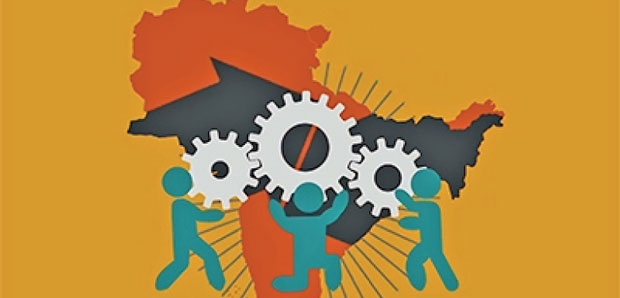20 Apr 2017 - {{hitsCtrl.values.hits}}

By Deepa Kylasam Iyer
South Asia comprises only 3.5 percent of the world’s surface area but houses 24.8 percent of the global population spread over eight countries. It has people from hundreds of ethno-linguistic groups and at least seven major religious identities.
While South Asia is predicted to grow at the rate of 7 percent in 2017, it holds only 1.3 percent of the world’s income with nearly 90 percent of the workforce in the informal sector. The nature of economic growth and development that South Asian countries have pursued over the last 25 years has been unexceptionally neoliberal.
The South Asia Poverty Report 2016 brought out by the South Asia Alliance for Poverty Eradication (SAAPE) looks at some of these issues from an inter-country perspective. It examines the nature of development through the changing nature of the state.
In post-colonial economies with a highly-stratified society and multiple religious, linguistic and ethnic identities, the state was originally conceived as a transformative institution that would build an egalitarian society. India’s constitution, speaking of fundamental rights and directive principles, is an example of a transformative constitution. Transformation was sought to be achieved through the application of redistributive welfare policies and the institution of public-funded agencies that made access to services affordable
and equitable.
It is this conception that has been overthrown by the advent of the neoliberal economic model.
Withdrawing state?
While economic growth has been more robust in the last decade in many South Asian economies, it has been accompanied by greater inequality. The destruction of agriculture and informalisation of labour have been the two major deleterious consequences of the growth. Informalisation in labour increased with the idea of contractual work, absence of enforced minimum wages and withdrawal of state-sponsored social security. In agriculture, increasing land dispossession, bondedness of labour and food insecurity have
been remarkable. The distress in these sectors is indicated by large-scale migration within and across countries, the debt crisis of the peasantry, food insecurity and farmer suicides.
Though the state has been described as ‘withdrawing’, ‘receding’ and ‘weakening’, it has only done so in select sectors. It has shown three tendencies that point to the nature of its transition. The first is the wilful neglect and degradation of public institutions such as schools, hospitals and universities, eventually giving them over to the private sector. For example, public health expenditure as a share of gross domestic product (GDP) was as low as 0.8 and 0.9 percent, respectively for countries such as Bangladesh and Pakistan against the global recommendation of 6 percent.
The second tendency is to withdraw social security amidst declining employment opportunities. The response of the state to the demands of employment and welfare benefits has been more ‘growth’ through the opening of natural resources to markets, extending easy credit to distressed classes such as peasants and rapid urbanisation through the nodal development of smart cities.
Strong force
Social movements have been the single largest force opposing these policies. This brings us to the third facet of the new state — growing militarisation. An uneasy nexus between the state and religious fundamentalist groups in Bangladesh and the Maldives, state and feudal groups in Pakistan and Afghanistan and state and finance capital in India and Sri Lanka have given birth to extremist elements dictating public policy. Under the Taliban rule, only 3 percent of girls received any form of primary education in Afghanistan. The withdrawal of state from the economy has meant that for Kuchi youth in the Khost province in Pakistan, planting road mines fetch them US $ 16-80 a day as opposed to daily wage of US $ 4 a day. In all South Asian countries, it is not surprising that a low gender empowerment index coexists with a low human development index.
The common threats of informalisation of labour, withdrawal of social protection and rising unemployment coexists with increasing militarisation and loss of freedom of expression, association and religion. As a result, social movements are espousing causes beyond their erstwhile narrow objectives. For instance, the labour movement in India has successfully negotiated for maternity benefits and the Sri Lankan university teachers’ movement has demanded high-quality public education. People are emerging as the connecting link between equity and growth and therefore moving towards forging a pan South Asian identity. Hope for the future of defining development in South Asia lies in the people’s struggles for basic rights.
(Courtesy The Hindu Business Line)
(Deepa Kylasam Iyer is a lead editor of South Asia Poverty Report 2016)
25 Nov 2024 1 hours ago
25 Nov 2024 1 hours ago
25 Nov 2024 2 hours ago
25 Nov 2024 2 hours ago
25 Nov 2024 3 hours ago